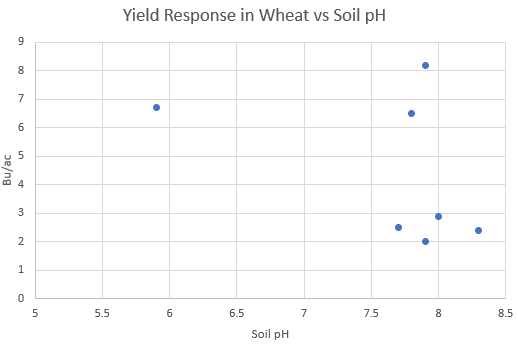Suspect a nutrient deficiency? One of the first things to check is your pH.
In a controlled environment, like greenhouses, pH can be adjusted easily.
In the field... it can be far more challenging and variable.
We generally have two tools in the box. Liming to raise pH on more acidic soils, and acidification usually with elemental sulfur.
More on those in these great articles:But even then, some soils (like calcareous soils) thanks to their chemistry, just can't be changed in an economically feasible way for many farming operations. And so, as all farmers do when faced with a challenge, adapting to the soil rather than trying to change it might be a better strategy.
At Lucent Bio, we think Soileos is another tool for farms who adapt their growing strategies for high pH soils.
Real quick, pH is a logarithmic scale (with values from 0 [acid] to 14 [alkaline]) that indicates where something lies on the spectrum of acidic to alkaline. The log part just means each unit change is 10x more than the unit before it. So something with a pH 9 is 10x more alkaline, than something with pH 8.

So why is pH an important consideration in any nutrient management plan? The availability of nutrients can be significantly impacted by pH. In general, soil solution Zn concentrations increase fivefold per unit pH decrease. (1)
There are many versions of this graph, but the story is the same. Nutrients change in availability, and in particular a high pH can make certain nutrients less available.
So why care? Well most of Western Canada's soils tend towards the more alkaline soils, and historically these soils have been more challenging to find effective sources of nutrients.
All one needs to do is check out these maps of Saskatchewan and Manitoba to see that large swaths of arable land have higher pHs. (Basically all the green and brownish color in both maps!)
pH of Saskatchewan Soils


You even see high pH in several US States.

And finally, take a look at some of the data we've collected. For example from our wheat trial near Saskatoon, Saskatchewan this summer.

This soil had Zinc levels at 2.66 ppm (according to the lab test sufficient), but also had a high pH of 7.7. There was no response from zinc sulfate, but there was a 7.9 bu/ac gain in the Soileos treatment!
In fact we've seen a great response in wheat in a variety of pH levels. And part of why we think that is happening is that regardless of pH the cellulose substrate protect the nutrients from tie-up or leaching. As the cellulose breaks down, nutrients are mobilized and this "smart biological" release results in more efficient delivery of nutrients when your plants need them most.
Here's a summary of the yield response we've seen in wheat across Soil pH:

Even our trial partners have had mostly high pH!
So if you've tried a micronutrient product in the past, and not seen much response. We believe you!
If you're interested in learning more about Soileos and whether or not it would be a good fit for your operation, ask your retailer, or contact us directly.

